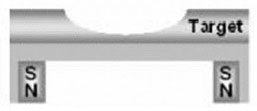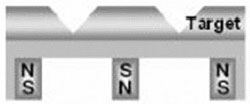New Facing Targets Sputtering System
Overview | Features | Principle | Applications | Product Information
The Principles and Properties of Conventional Facing Targets Sputtering (CFTS) and New Facing Targets Sputtering (NFTS)
CFTS Structure | CFTS/CMS Differences | CFTS Issues | NFTS Improvements | NFTS Plasma Source
Differences of Thin Films Prepared by CFTS and CMS
CMS plasma is characterized to be generated in the space between a target and a substrate surfaces. Therefore, the substrate surface can be directly bombarded by electrons and negative ions with high kinetic energy from target surface. The irradiation of a large amount of secondary electrons ejected from the target surface to the substrate surface results in large increase in temperature of the substrate surface. Additionally, bombardment of negative ions with high kinetic energy can damage the film structure growing on the substrate. Therefore, these bombardments can bring about damage of the depositing films quality such as a strong internal stress and increased surface roughness. Thus, CFTS technology is advantageous for the usage of low heat resistant temperature substrates such as plastic films, multi layers, organic materials and semiconductors that have high sensibility to plasma damage. In reactive sputtering with oxygen or nitrogen gas, CFTS technology can prepare high quality oxide or nitride thin films at high deposition rate. The thin films prepared by CFTS have the property of closely packed structure, low internal stress, smooth surface and superior interface between the thin films compared to CMS.
CMS plasma is characterized to be generated in the space between a target and a substrate surfaces. Therefore, the substrate surface can be directly bombarded by electrons and negative ions with high kinetic energy from target surface. The irradiation of a large amount of secondary electrons ejected from the target surface to the substrate surface results in large increase in temperature of the substrate surface. Additionally, bombardment of negative ions with high kinetic energy can damage the film structure growing on the substrate. Therefore, these bombardments can bring about damage of the depositing films quality such as a strong internal stress and increased surface roughness. Thus, CFTS technology is advantageous for the usage of low heat resistant temperature substrates such as plastic films, multi layers, organic materials and semiconductors that have high sensibility to plasma damage. In reactive sputtering with oxygen or nitrogen gas, CFTS technology can prepare high quality oxide or nitride thin films at high deposition rate. The thin films prepared by CFTS have the property of closely packed structure, low internal stress, smooth surface and superior interface between the thin films compared to CMS.



